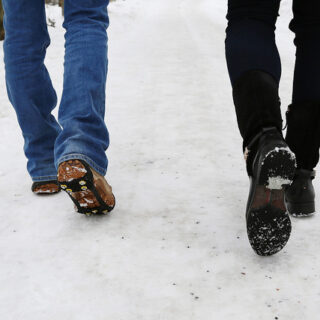Take your time, avoid rushing and stay on your feet when it is slippery outside
Slippery streets may take pedestrians by surprise in the early winter, when they have not gotten used to icy streets yet. The ‘Pysy pystyssä’ campaign reminds Finns to pay attention to slippery conditions – avoiding having to rush is key to managing to stay upright. Each year, slipping and falling accidents cause distress and generate costs to individuals, workplaces and society alike.

You should start paying attention to slippery conditions in early winter, as you are probably not yet used to streets being slippery. You should focus on walking when you walk and avoid having to rush, because it increases the risk of slipping and falling.
”Even in the height of Christmas hustle and bustle, you should look at where you are going, or your holidays might be ruined. You might be trying to catch your bus, for example, and forget to look out for slippery spots – even if you had been careful just a moment before. Christmas and the next bus will still be there, even if you slow down,” says Laura Loikkanen, Planning Officer at the Finnish Road Safety Council.
Working-age people are prone to slipping and falling, even motorists. Dangerous locations include the driveway at home and the parking lot at work. The best way to avoid slipping and falling when in a hurry is tried and true: anticipation, or making sure that you have enough time to get to places. A simple way to live by this rule is to leave home about five minutes earlier than you normally do.
”No one plans on slipping and falling, which is why you should prepare for slippery conditions – it is not about age, but conditions. However, the injuries caused by slipping and falling tend to be more severe in the elderly compared to younger people. In addition to avoiding having to rush and focusing on walking, anti-slip guards or shoes with a good grip are an easy way to prevent slipping. You should also monitor weather reports for pedestrians,” Loikkanen says.
The high cost of slipping and falling accidents
Slipping and falling accidents generate a lot of costs for society. According to the National Institute for Health and Welfare (THL), inpatient care required for injuries caused by slipping and falling in the winter costs on average 18 million euros a year*.
Roughly 4,600 patients* are admitted to inpatient wards due to injuries sustained by slipping and falling each winter. According to an estimate by THL, a further 11,000 patients* usually visit outpatient care annually due to slipping and falling in winter conditions.
”In addition to medical treatment, costs are also incurred for workplaces, because victims of injuries must often miss work. And we should not forget about the pain, distress and other challenges that victims encounter in their everyday lives. The repercussions of slipping and falling may make it very difficult to manage everyday life at home and at work,” says Persephone Doupi, senior researcher at the National Institute for Health and Welfare.
*Average based on data from 2015–2017. The statistics on patients in inpatient and outpatient care may overlap, meaning that the total number of patients may be somewhat smaller.
Here’s how you can prepare for slippery conditions and stay on your feet:
- Pay attention to your choice of footwear – shoes with a good grip have low, wide heels and an outsole made of soft material with good traction.
- Focus on walking. If you are paying attention to things like your mobile phone, instead of walking, you can be taken by surprise by the slippery conditions.
- Be prepared. When you are alert, you are better equipped to avoid slippery areas.
- Use anti-slip guards – anti-slip guards attached to the shoes or permanent studs fixed to the shoes provide good traction.
- Check for warnings. You can check the pedestrian weather report on the Finnish Meteorological Institute website, for example.
- Provide feedback on the maintenance of courtyards and passageways – or spread gritting sand on the yard yourself, if possible. Spreading gritting sand and clearing away snow helps others stay upright, as well.
- Maintain good physical health. Being in control of your own body and being in good physical condition help you to remain upright.
- Be aware, especially in the festive season, of the fact that alcohol in your bloodstream elevates the risk of slipping and falling.
More information:
General information about the campaign
Campaign Chair Kaarina Tamminiemi
(Tel. +358 (0)40 577 4614, kaarina.tamminiemi@cancer.fi)
On preventing slipping and falling accidents
Planning Officer Laura Loikkanen, the Finnish Road Safety Council (tel. +358 (0)20 7282 341, laura.loikkanen@liikenneturva.fi)
Statistics on slipping and falling accidents and expenses
Senior Researcher Persephone Doupi, THL (tel. +358 (0)29 524 7383, persephone.doupi@thl.fi)
On pedestrian weather reports
Senior Meteorologist Sari Hartonen, Finnish Meteorological Institute (tel. +358 (0)29 539 3444, sari.hartonen@fmi.fi)
Links:
The ‘Pysy pystyssä’ anti-slipping campaign (in Finnish): pysypystyssä.fi
Warnings (including weather reports for pedestrians): ilmatieteenlaitos.fi/warnings
Your observations (in Finnish): ilmatieteenlaitos.fi/omat-havainnot
Watch videos:
When and where are you most likely to slip and fall? (in Finnish)
Risk groups of slipping and falling accidents and the most typical injuries (in Finnish)
The ‘Pysy pystyssä’ campaign promotes pedestrian safety in the winter. The campaign can be heard on the radio and seen on social media 13–26 January 2020. Follow: #pysypystyssä and @kotitapaturma.
‘Pysy pystyssä’ campaign partners:
Aivovammaliitto, EHYT Finnish Association for Substance Abuse Prevention, the Network for Preventive Substance Abuse Work, Finance Finland, City of Helsinki, Finnish Meteorological Institute, Finnish Association of People with Physical Disabilities, Finnish Road Safety Council, LähiTapiola, National Defence Training Association of Finland (MPK), Nikander ja Wiinikka Oy, Partioaitta, Sarva studded shoes, Finnish Ministry of the Interior, Ministry of Social Affairs and Health, Association of Finnish Local and Regional Authorities, Finnish National Rescue Association, Finnish Red Cross, SOSTE Finnish Federation for Social Affairs and Health, Finnish Swimming Teaching and Lifesaving Federation, Taitavat Suutarit ry, National Institute for Health and Welfare, Finnish Safety and Chemicals Agency (Tukes) and Finnish Institute of Occupational Health. The Funding Centre for Social Welfare and Health Organisations (STEA) also supports the campaign.
Can you use the information on this page?
Give Feedback
With this form you can give us feedback.
You may also be interested in
-

Two out of five people have ended up in hazardous situations due to slippery shoes
According to a new survey by the Finnish Road Safety Council, up to 40 per cent of Finns say they have experienced a hazardous situation in … -

Keep your feet on the ground this festive season – despite the increased risk
If the pavements are slippery during the festive season, it is reflected in a peak in pedestrians falling accidents and people hurting thems… -

One in three finds studded shoes or anti-slip guards too cumbersome – despite obvious benefits
The ‘Pysy pystyssä’ campaign reminds you that you can be prepared for slippery winter conditions by wearing studded shoes or anti-slip guard… -

Roughly one in three Finns will slip and fall during the winter – you can prevent falls by making small changes
More than one million accidents occur each year in Finland, of which more than one third are various kinds of slips and falls. You can also …
